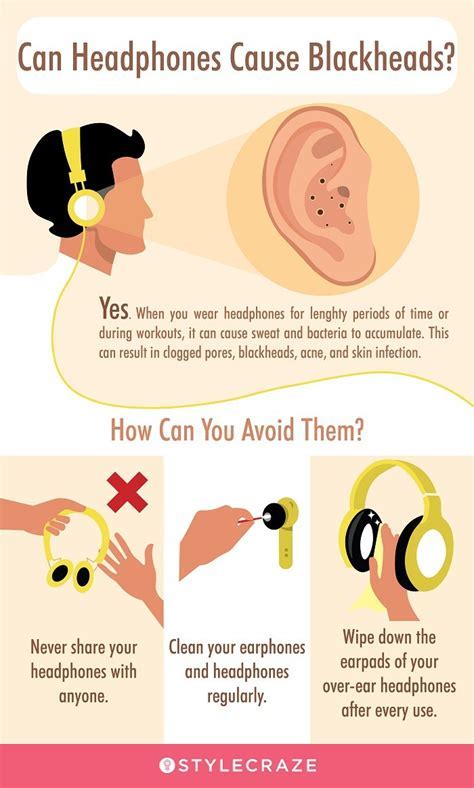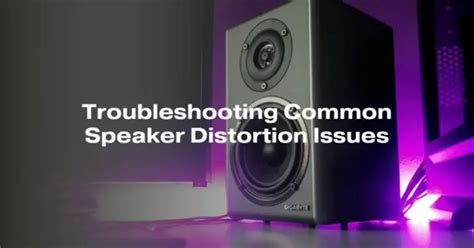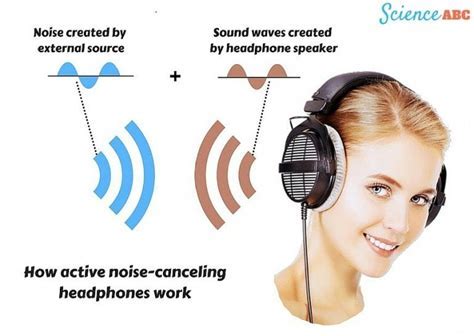Have you ever experienced that nagging sensation when your earphones emit a hiss or crackling noise while you are trying to enjoy your favorite tunes? It's as if the audio quality is being tainted by some unwelcome guest, leaving you frustrated and searching for a solution. We've all been there – tangled in a web of distortion that mars our audio experience.
Discovering the cause of this disruptive static can be like searching for a needle in a haystack. It's an intricate problem that requires careful attention to detail and a deep understanding of the technology behind audio devices. Fear not, for we have taken it upon ourselves to demystify this enigma so that you can finally bid adieu to those annoying crackles and pops that accompany your musical journey.
Picture this: you are immersed in a world of melody, headphones gently resting on your ears, when suddenly, the tranquility is shattered by the intrusion of distortion. Your favorite song loses its magic, and you find yourself yearning for a seamless audio experience. But fret not, fellow music lover, as we embark on a journey to unveil the reasons behind audio static in headphones and equip you with the knowledge to fix it.
Understanding the Causes of Interference in Headphones and Effective Prevention Strategies

When using headphones, it is not uncommon to experience unwanted noise or distortion, commonly known as audio static. This interference can significantly disrupt the listening experience, making it essential to identify the underlying causes and implement preventive measures. By understanding the factors that contribute to audio static in headphones, you can take proactive steps to minimize or eliminate this issue.
Electromagnetic Interference (EMI):
One primary cause of audio static in headphones is electromagnetic interference. EMI refers to the disturbance caused by electromagnetic radiation, which can originate from various sources such as electronic devices, power lines, or wireless signals. When EMI interferes with your headphones' audio signal, it can manifest as static, crackling sounds, or intermittent disruptions.
To prevent EMI, consider the following measures:
- Keep your headphones away from electronic devices that emit strong electromagnetic fields, such as smartphones, laptops, or routers.
- Use shielded audio cables or headphones specifically designed to minimize EMI.
- Avoid crossing or bundling cables, as this can increase the likelihood of interference.
Wireless Interference:
Another potential cause of audio static is wireless interference. With the increasing popularity of wireless headphones, the likelihood of encountering this issue has also risen. Wireless interference can occur when multiple wireless devices operate within close proximity or if there are signal disruptions in the surrounding environment.
To prevent wireless interference, consider the following strategies:
- Ensure your headphones and the audio source are within the recommended range for optimal signal transmission.
- Minimize obstructions between the headphones and the source, such as walls or other electronic devices.
- Switch to a different wireless frequency or channel if applicable, as this can help mitigate interference from nearby devices.
Physical Cable Issues:
In some cases, audio static may be caused by physical cable issues, such as loose connections or damaged cables. These issues can result in poor signal transmission, leading to audio distortion or static noise. Therefore, it is necessary to inspect and maintain the quality of your headphone cables regularly.
To prevent physical cable issues, consider the following precautions:
- Regularly check the cables for any visible damage or wear and tear.
- Ensure all connections are secure and properly plugged in.
- Avoid bending or twisting the cables excessively, as this can lead to internal wire breakage.
In conclusion, addressing audio static in headphones requires a comprehensive understanding of the potential causes and effective prevention strategies. By implementing the preventive measures mentioned above and staying attentive to the quality of your headphone cables, you can significantly reduce the likelihood of experiencing audio static, thereby enhancing your overall listening experience.
Understanding the Causes of Audio Interference
When using our personal listening devices, we expect high-quality audio without any disturbances. However, at times, we may experience unwanted background noise or static that can detract from our listening experience. To better understand and address this issue, it is important to delve into the underlying causes of audio interference.
- Electromagnetic Interference: This occurs when electronic devices emit electromagnetic waves that can interfere with headphone signals. Common sources of electromagnetic interference include power lines, radios, cell phones, and even other headphones.
- Wired Connection Issues: Audio static can also result from problems with the headphone cables and connectors. Loose or damaged cables, poor connections, or improper grounding can introduce unwanted static into the audio signal.
- Environmental Factors: The surrounding environment can contribute to audio interference. For instance, proximity to electrical outlets, electronic equipment, or strong magnetic fields may introduce static and affect audio quality.
- Signal Interference: In some cases, multiple audio sources or electronic devices operating in the same frequency range can cause signal interference, resulting in static in headphones. This may be observed when using wireless headphones or Bluetooth devices.
- Audio Device Malfunctions: Occasionally, audio static may be attributed to malfunctions in the audio devices themselves. Issues such as outdated firmware, driver conflicts, or faulty components can contribute to static and distortion in the audio output.
By understanding what factors can cause audio static in headphones, one can take appropriate measures to minimize or eliminate these disturbances. From addressing electromagnetic interference to ensuring proper cable connections and avoiding sources of signal interference, troubleshooting the root causes allows us to enjoy clear and uninterrupted audio experiences.
Troubleshooting Common Issues with Distorted Sound

In this section, we will explore various troubleshooting techniques to address common problems related to distorted audio output. We will discuss potential causes and provide practical solutions to eliminate static or crackling noises in your audio experience.
One of the common culprits behind audio static is interference from external sources. It could be electrical devices, wireless networks, or even nearby electronic equipment. Identifying and minimizing these sources of interference can significantly improve your audio quality. Additionally, loose or faulty connections between your audio devices can also contribute to static or distorted sound. We will explore methods to check and resolve such issues.
Another factor that can lead to audio static is outdated or incompatible drivers. Ensuring that your audio drivers are up to date and compatible with your operating system can go a long way in preventing static sounds. We will discuss how to update drivers and troubleshoot compatibility problems.
Additionally, software conflicts and audio settings can also impact the audio output. Adjusting audio settings appropriately, disabling unnecessary audio enhancements, and identifying any conflicting software can help resolve static sound problems. We will provide step-by-step guidance on how to troubleshoot such software-related issues.
Furthermore, it is important to consider the quality of your audio files or streaming sources. Low-quality audio files or streaming services can introduce unwanted static or crackling noises. We will discuss how to identify and address these quality-related issues to improve your audio experience.
Lastly, we will offer some general tips and best practices to prevent audio static in headphones. These tips will include maintaining proper headphone care, minimizing exposure to extreme temperatures or humidity, and avoiding abrupt volume changes. Implementing these practices can help prolong the lifespan of your headphones and ensure a consistent audio experience.
Reducing Interference through Effective Cable Management
Proper cable management plays a crucial role in minimizing interference and ensuring high-quality audio output. By organizing and securing your audio cables appropriately, you can significantly reduce the occurrence of static and other unwanted noises in your headphones.
1. Avoiding Cable Tangles:
One of the primary causes of audio static is cable tangles. Twisted or knotted cables can create electromagnetic interference, leading to static in the headphone audio. To prevent this, ensure that your cables are untangled and laid out in a neat manner. Employing cable ties or clips can help keep them organized and prevent them from tangling with other devices or furniture.
2. Separating Audio Cables from Power Cords:
Another common source of interference is the proximity of audio cables to power cords. Whenever possible, ensure a significant distance between these two types of cables. By separating them, you can reduce the chances of electromagnetic interference that could lead to static in your headphones.
3. Using Shielded Audio Cables:
Investing in shielded audio cables can make a significant difference in reducing static. Shielded cables have an additional conductive layer that prevents external electromagnetic interference from affecting the audio signal. By incorporating shielded cables into your audio setup, you can effectively minimize static and enjoy a clearer audio experience.
4. Proper Cable Routing:
When setting up your audio system, pay attention to the routing of the cables. Avoid running audio cables parallel and close to power cables or other sources of interference, such as Wi-Fi routers or fluorescent lights. Instead, opt for separate routes or use cable management solutions like cable raceways or conduits to keep the audio cables isolated and minimize the risks of static.
5. Regular Cable Maintenance:
Lastly, make it a habit to regularly inspect and maintain your audio cables. Check for any signs of damage or wear and tear, such as frayed insulation or loose connectors. Replace or repair any damaged cables promptly as they can contribute to audio static. Keeping your cables in good condition will help ensure optimal audio performance and minimize the occurrence of unwanted noise.
By utilizing these effective cable management techniques, you can significantly reduce static and other interference in your headphone audio, resulting in a more enjoyable and immersive listening experience.
Shielding Techniques to Reduce Interference in Headphone Audio

Within the realm of headphone audio, unwanted interference can often manifest as an annoying hissing or crackling sound. This section explores effective shielding techniques that can be employed to minimize this interference and enhance the overall audio experience.
- Use Balanced Cables: Consider utilizing balanced cables instead of unbalanced ones, as they can help reduce interference caused by external electromagnetic fields.
- Implement Ferrite Beads: Incorporating ferrite beads can be beneficial in attenuating high-frequency electromagnetic interference (EMI) that may compromise audio quality.
- Employ Shielded Audio Cables: Shielded audio cables can act as a barrier against electromagnetic fields, preventing them from interfering with the headphone audio signal.
- Grounding Techniques: Proper grounding of audio equipment, including headphones, can minimize the risk of interference and improve signal quality.
- Locate Power Sources Away from Headphones: Positioning power sources, such as adapters or chargers, at a distance from headphones can help reduce electromagnetic interference that may affect audio playback.
- Reduce Cross-Talk: Employing techniques to minimize cross-talk between channels can further enhance audio clarity and reduce the potential for interference.
- Consider Shielded Headphone Design: When purchasing headphones, choose models that incorporate shielding techniques within their design to provide an extra layer of protection against interference.
By implementing these shielding techniques, headphone users can mitigate the effects of electromagnetic interference, greatly improving audio quality and providing a more immersive listening experience.
Best Practices for Maintaining Optimal Sound Quality and Minimizing Interference
In order to ensure a pristine audio experience and avoid unwanted disturbances, it is crucial to adopt effective strategies for preserving audio quality and preventing any form of interference.
- Invest in high-quality audio equipment: Acquire headphones or audio devices from reputable manufacturers known for their superior sound quality and advanced technologies.
- Ensure proper cable management: Avoid tangled cables as they can create unwanted electrical noise. Organize and secure cables to minimize the risk of signal interference.
- Keep headphones and audio connectors clean: Regularly clean headphone jacks, connectors, and cables to remove buildup of dust and debris that can impact audio transmission.
- Maintain appropriate volume levels: Listening at excessively high volumes can cause distortion and introduce static. Always adjust the volume to a comfortable and safe level.
- Minimize background noise: Choose a quiet environment whenever possible to reduce ambient sound that may interfere with audio clarity. Consider using noise-canceling headphones for additional isolation.
- Check for software and firmware updates: Stay up-to-date with the latest software and firmware versions provided by the manufacturers. These updates often include improvements in audio performance and bug fixes that can reduce static.
- Avoid audio signal conflicts: Keep electronic devices or appliances that emit electromagnetic waves away from audio sources to prevent interference. Examples include cell phones, microwave ovens, and other wireless devices.
- Regularly inspect and replace damaged accessories: Over time, cables, connectors, and ear pads can become worn or damaged, affecting audio quality. Check for any signs of wear and tear and replace them accordingly.
- Properly store headphones when not in use: Protect headphones from physical damage and extreme temperatures by storing them in a clean and safe location. Consider using a protective case or pouch.
- Consult with professionals if issues persist: If static or audio quality problems persist despite following these best practices, it may be necessary to seek assistance from experts or specialized technicians who can diagnose and resolve the underlying issues.
By incorporating these best practices into your audio routine, you can ensure optimal sound quality and minimize the occurrence of static and interference for an immersive and enjoyable listening experience.
FAQ
Why do I hear static in my headphones?
There can be several reasons why you hear static in your headphones. It could be due to a poor connection, interference from other electronic devices, a faulty audio cable, or even an issue with your audio source.
How can I fix the static noise in my headphones?
To fix static noise in your headphones, you can try several potential solutions. First, make sure your headphones are properly connected and check for any loose connections. If that doesn't help, try using a different audio cable or switching to a different audio source. Additionally, keeping your headphones away from other electronic devices can minimize interference.
Is there a way to prevent static in headphones from occurring?
While it may not be possible to completely eliminate the chances of static in headphones, there are some steps you can take to minimize the occurrence. Using headphones with good shielding, properly grounding your audio equipment, and staying away from sources of interference can significantly reduce static. Regularly checking and maintaining your headphones and audio devices can also help prevent static issues.




